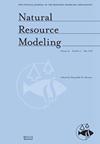当盈利能力通过生物多样性抵消达到保护目标时
IF 2.1
4区 环境科学与生态学
Q3 ENVIRONMENTAL SCIENCES
引用次数: 0
摘要
生物多样性补偿(BOs)越来越多地被用作经济手段来管理经济发展背景下的生物多样性和生态系统服务。本研究探讨了BOs的可持续性条件。它特别侧重于发展抵消项目中bo的时间和定价。为了解决这个问题,提出了一个最小时间控制模型,允许通过生态和经济目标结合动态和多标准方法。我们在这里依赖于无净损失(NNL)和正净现值(NPV)目标。我们特别关注抵消边际价格,称为抵消可持续性价格(OSP),它使NNL和投资回收期相等。我们分析地证明了OSP定价在生态经济协同作用方面是如何对应于双赢解决方案的。我们还表明,与项目回报率相比,OSP定价可能非常高,特别是在生物多样性损失很高的情况下。在全球范围内,静态比较分析显示了经济和生物多样性参数影响OSP的程度。最后,与马达加斯加红树林和水产养殖有关的数值应用说明了分析结果。对于本案例研究,我们认为当前的收购价格被低估了。本文章由计算机程序翻译,如有差异,请以英文原文为准。
When profitability meets conservation objectives through biodiversity offsets
Biodiversity offsets (BOs) are increasingly used as economic instruments to manage biodiversity and ecosystem services in the context of economic development. This study investigates the sustainability conditions of BOs. It focuses especially on both the timing and pricing of BOs in development-offset projects. To address this issue, a minimal time control model is proposed, allowing a dynamic and multicriteria approach to be combined through both ecological and economic targets. We rely here on no net loss (NNL) and positive net present value (NPV) goals. In particular, we focus on an offset marginal price, called offset sustainability price (OSP), which equalizes the NNL and payback times. We prove analytically how this OSP pricing corresponds to a win–win solution in terms of ecological-economic synergy. We also show that this OSP pricing can be very high compared to the project rate of return, particularly when the biodiversity loss is high. More globally, a static comparative analysis shows the extent to which the economic and biodiversity parameters impact the OSP. Finally, a numerical application related to mangroves and aquaculture in Madagascar illustrates the analytical findings. For this case study, we argue that the current BO price is underestimated.
求助全文
通过发布文献求助,成功后即可免费获取论文全文。
去求助
来源期刊

Natural Resource Modeling
环境科学-环境科学
CiteScore
3.50
自引率
6.20%
发文量
28
审稿时长
>36 weeks
期刊介绍:
Natural Resource Modeling is an international journal devoted to mathematical modeling of natural resource systems. It reflects the conceptual and methodological core that is common to model building throughout disciplines including such fields as forestry, fisheries, economics and ecology. This core draws upon the analytical and methodological apparatus of mathematics, statistics, and scientific computing.
 求助内容:
求助内容: 应助结果提醒方式:
应助结果提醒方式:


